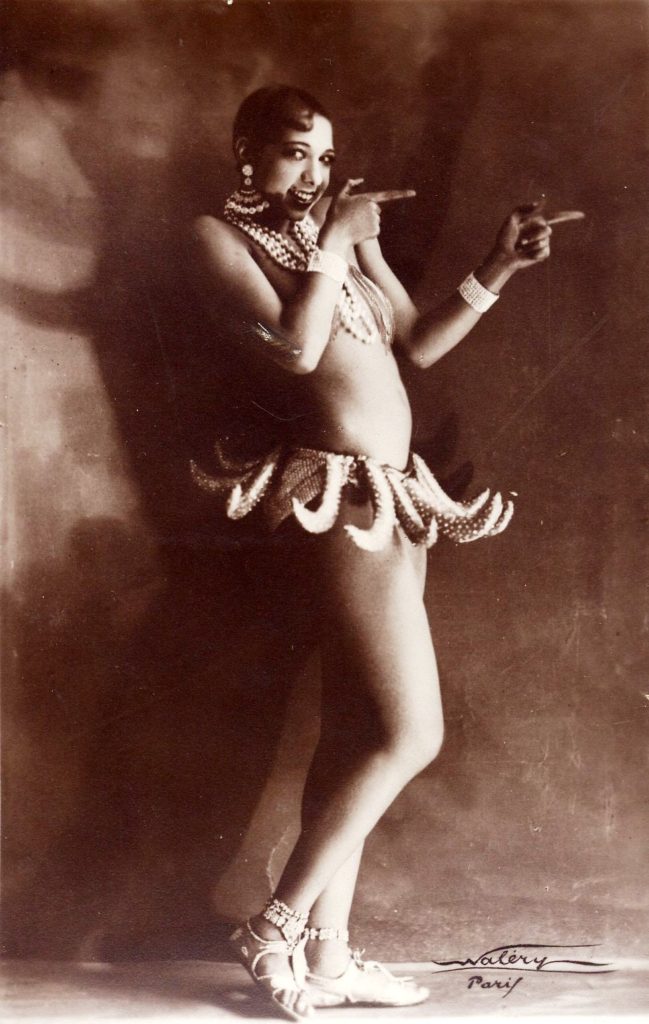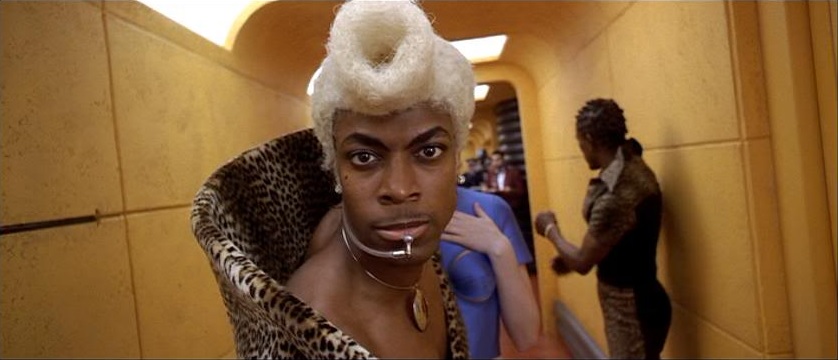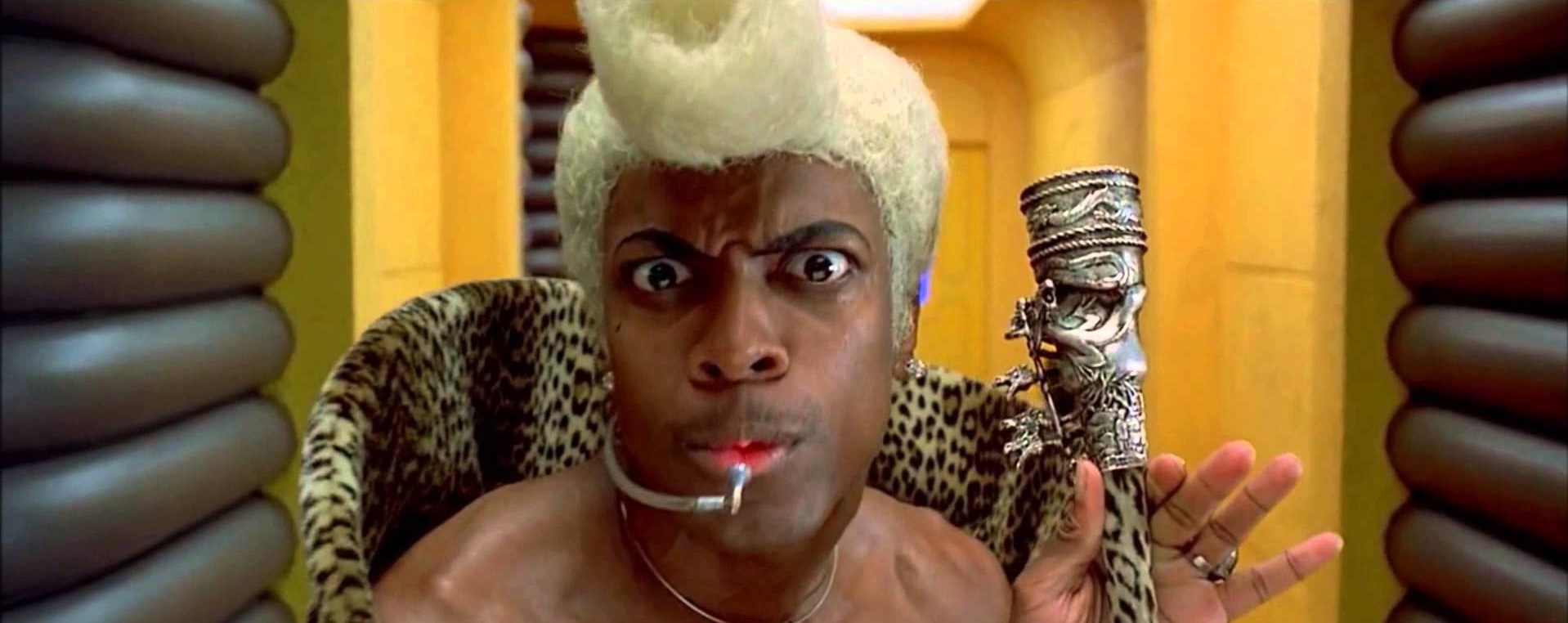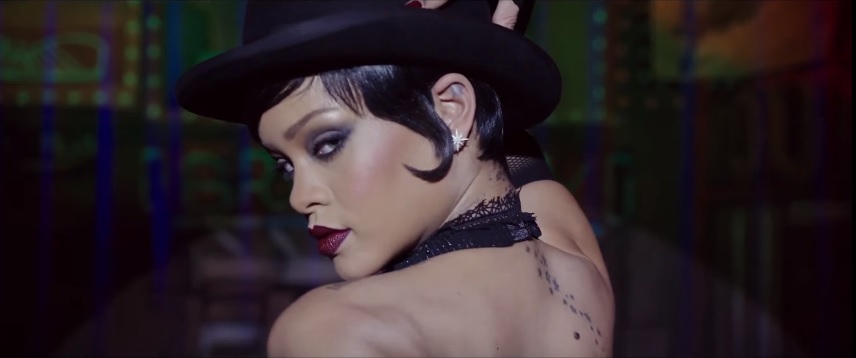Valerian and the City of a Thousand Planets is coming out this month, and upon seeing Rihanna as the alluring dancer Bubble in the various trailers, I knew there was something to discuss, particularly how Bubble relates to another black character in a Luc Besson sci-fi film, Chris Tucker’s Ruby Rhod.
How so? You might be saying. Well, from where I’m sitting, having two characters who are at a crossroads between Afrofuturistic empowerment and reductive racial stereotypes begs to be written about. Clearly, these two characters are talking to each other, and deciphering their conversation is one that involves parsing through how blackness, black queerness, and black sexuality are constantly put at war against each other in Western society. These two characters embody that tug of war between ownership and exploitation.
With that said, let’s get into it.
Ruby as a statement—and condemnation—on black queerness
As a character, Ruby Rhod is an absolute conundrum. To put it bluntly, he’s the most singular character in The Fifth Element and certainly one of the most singular in sci-fi films as a whole. As Drew Mackie from UnicornBooty wrote, Ruby Rhod is “a queer-coded character the likes of whom audiences likely hadn’t seen before in a mainstream ‘popcorn’ movie—and by and large haven’t seen since.”
Ben Child for the Guardian breaks Ruby’s character down into even more detail:
“Decked out in extravagant Jean-Paul Gaultier outfits, and spending most of the movie either squealing in high-camp horror at the sight of aliens taking over a luxury intergalactic cruise ship or luring fluttery-eyed space vixens into virtual orgasms merely by his presence, Rhod is a character whose rejection of gender norms is so elevated that they seem to have arrived through a wormhole from the year 3000, never mind 2263 (The Fifth Element’s ostensible time frame). At one point Tucker chooses to be called ‘Miss’ Ruby, and yet there is a definite hint of phallicism in that rock star surname. Moreover, Rhod appears to be the very definition of red-blooded masculinity. Is it any wonder that Prince was the model for the role, with Tucker only recruited once it became clear the purple one was not going to sign on the dotted line?”
Ruby is a fascinating character to dissect because, whether Besson or Tucker realized it, Ruby’s at the center of the intersections of black queerness, black masculinity, and the influence of black American culture on mainstream pop culture.
The thing that’s the most apparent about Ruby, aside from being black, is that he’s most definitely a representation of queerness. I’m specifically using that term because as a character, Ruby doesn’t seem to define himself as straight or gay. While he overtly makes references to heterosexual sex, what with his seduction of the spaceship’s stewardesses, his spectacular rose-lined outfit, eye makeup, and tinted lip gloss suggests he’s subtly giving his time at the opera with Bruce Willis’ Korben Dallas date-like undertones instead of merely a PR opportunity with a contest winner.
Speaking of his clothes, Ruby’s costumes directly reflect his gender-bending and sexually fluid sensibilities. Ruby doesn’t wear mere garments. He wears statements. His leopard print unitard exaggerate the feminine collars of the 1950s while also defining his very masculine bulge. His aforementioned opera outfit veers even more into feminine territory.
Ruby is at once a shining moment of Hollywood’s progressiveness and Hollywood’s tight grip on queer stereotypes.
Saeed Jones wrote for Lambda Literary about the push-and-pull effect he gets from Ruby, one of his favorite characters from the film.
“When I was a teenager obsessed with The Fifth Element, I was devoted to the idea that Ruby Rhod was a gay character who gets to take part in saving the universe. Except Ruby isn’t gay. I didn’t know about the phrase ‘gender bending’ at the time and had no schema for an effeminate male character who has sex with more women in the film than the macho protagonist. Ruby was a kind of man I thought would only be possible light years into the future: funny, black, attractive, fierce, and—most importantly—alive by the end of the movie.”
Yet, Ruby falls into many tropes that intersect with both the obsession of showing “black buffoonery” and “girly” gay men. Ruby’s blend of machismo and femininity is what gives the character power in the scenes where he’s in control. But it’s when the action starts that Ruby’s power dissolves into frantic screams worthy of a fainting couch. He becomes the worst type of damsel-in-distress—one who cowers behind the man, lacking the fortitude to use calm or logic in tense situations.
In one way, it’s daring that The Fifth Element even dared to show a black man—usually thought of as a lumbering, menacing powerhouse—as a lithe, vulnerable character taking on a traditionally femme role. However, that point could have been made more solidly if Ruby didn’t segue into eye-bulges and wacked-out facial expressions that are only reserved for the most buffoonish of black buffoons in media.
As much as Ruby uplifts the narrative of black queerness in the media, he also does just as much to cement a view of gay culture that has been traditionally held by a lot of people in the black community—that being gay or in any way an non-traditional male is the mark of a defective man. A lot of that view is based in a very limited view of Christianity, but the real root seems to be from the black man’s struggle to reclaim and express his masculinity in the first place.
David A. Love wrote in a 2012 opinion piece for The Grio that the traditional black aversion to homosexuality stems from slavery.
“Voices in the black community, particularly black gay men, point to black male insecurity as a root cause of black homophobia. And that insecurity comes directly from slavery. Since then, black men have struggled to get beyond this emasculation and redefine their image. It is for that reason that machismo traditionally has been highly valued among black people, and homosexuality viewed as a threat to black masculinity.”
Ruby plays into that perception of viewing black queerness as a threat—by acting in a cartoonish, stereotypical and racially-charged fashion, Ruby acts as an avatar for the very fears insecure black men have about black male homosexuality. Those fears aren’t crystalized more than when Ruby literally hides in fear behind Korben, the white male secure in his sexuality enough to take charge and lead the scared Ruby to safety.
To go back to Jones’ Lambda Literary article:
“Ruby Rhod troubles me. He explodes into the narrative, black, loud, and out of nowhere. Like the standard Magical Negro, he is functional in service of the film’s white heroes but has little to know story of his own. We know nothing about him except that he’s hilarious, really loud, and sexually promiscuous. When you set aside his costume choices, he’s really not that different from most black comic characters. In fact, he’s almost offensive…I’d rather not think about it.”
Even with that said, Tucker’s performance is one that makes Ruby one of the standouts from The Fifth Element. He’s vivacious, fun, and electric. Tucker takes Ruby seriously as an actor and channels Prince and Michael Jackson into the role, showing that Tucker gets what Ruby’s about. Speaking of Prince, Prince himself was supposed to play Ruby, but couldn’t do to prior tour commitments. If we look at how Prince played The Kid in Purple Rain and Christopher Tracy in Under the Cherry Moon, you have to wonder how Ruby’s gender and sexual explorations would have been played. Would Prince have challenged Besson about Ruby’s reactions to the first sight of danger or would he have gone along with Besson’s vision? I’m not a psychic or a mind reader, but I feel like Prince would have taken it upon himself to Jedi Mind Trick Besson into letting him rewrite the character into someone much more aware and much more willing to punch a bad guy in the face.
How Ruby Rhod gives possible clues to Bubble’s characterization
As of writing this post, we haven’t seen Valerian, so we don’t know much about Bubble. It also seems like she’s not in the original 1960s French comic books, so we don’t even have canon to draw from. But there are some things we can glean from the trailer from how Ruby Rhod was characterized in The Fifth Element.
Firstly, we see that there’s still the theme of blackness relating to entertainment in some way. Ruby’s claim to fame was being the universe’s most popular radio show host. Bubble’s claim to fame is being what outlets such as Billboard described as an “alien stripper,” but what other outlets have described as an “entertainer.” The idea seems to be that in Besson’s future, blackness is frequently tethered to—or defined by—the objectification and maybe even exploitation that comes with celebrity.
Both Ruby and Bubble are definitely cornerstones in their own universe’s cultures, and for that they are both exalted and exploited for things folks always expect black people to be good at—making music, dancing, and being sexual. They’re both enigmatic people and cariactures of our society’s incessant obsession with the black body, black sexuality, and black talent.
To further illustrate what I’m trying to say, I’ll use one of France’s most famous entertainers, Josephine Baker, as an example. She comes to mind for me because of the fact that eroticism featured heavily in her dance performances. Racial commentary also featured heavily—she often had a push-and-pull between exploiting racial stereotypes and subverting them in her acts. Her most famous act, in which she’s nude except for some sandals, necklaces, and her banana skirt, portrays knowledge of the hyper-sexual black “native” woman stereotype. She uses this stereotype to her advantage, but still, it showcases the Western obsession with the black body. In her acts, Baker becomes less of a dancer and more of an object, funneling all of Western society’s sexual fantasies about blackness into her performances.

Just from the trailers, Bubble seems to be a character at that same intersection. The only caveat is that it’s unclear just how much power she has over her own sexuality. In that respect, Ruby is more like Baker than Bubble is; we do see Ruby use his sexual prowess to his advantage (and, strangely enough, Ruby’s leopard suit brings up an animalism that is also apparent in Baker’s costumes).
How much can we expect to learn about Bubble in Valerian if we still don’t know a lot about Ruby 20 years after The Fifth Element’s release? I would say we should expect to learn nothing except that she’ll more than likely be defined by her singing and dancing talent, her sexuality—not only as an exotic dancer, but as a black woman, a race of women who have always been objectified and defined solely by sexual stereotypes. In fact, to use Jones’ words, having Bubble as a black woman whose main purpose for the film is to be used for her body is “almost offensive.” If Ruby was defined by stereotypes and not by motivations, it makes sense to expect that Bubble will also be a poorly-defined character.
However, I could be wrong. Like I wrote above, we haven’t seen the film yet. But if you’re going to see Valerian, take special care of how you view Bubble. At the very least, make sure to take care of her in your mind the same way many take care of Ruby Rhod.


